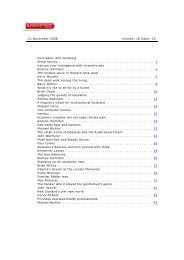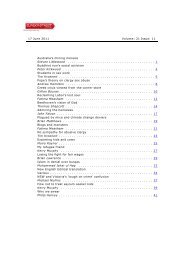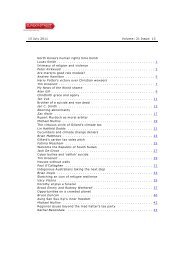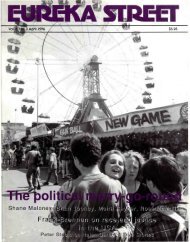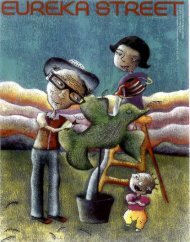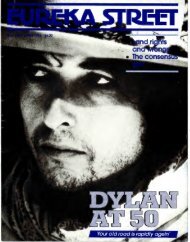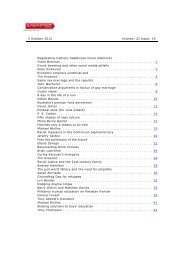Home truthsL '" "'" MOOCconfirmed cases of children who hadbeen t hrash ed, bashed, starved,raped, abandoned or neglected bytheir parents were reported to Australianwelfare authorities. The reportrate went up by 20 % in thefollowing 12 months, and is beingmaintained this year.The rising tide of child m altreatment,and our unwillingness to admitthat we have di sm ally failed toprotect children, is a national disgrace.We have clone enough ficlcllin gwith the system : it is time to trysom ething radically different.'Child abuse' is a generous andimprecise term, covering everything,from torture to nagging, in a context.Over the last couple of decades ourarm y of child protection experts hasbecome much more aware of thepossible harm to children from certainbehaviours, and much m orewilling to describe it as maltreatment:being exposed to severe violenceaga inst others, for in stance,and 'discipline' which causes pain,humiliation and fear.That knowledge has not, however,been transmitted to parents. Accordingto a recent report commissionedby the National Child ProtectionCouncil, but not released, 80 %of their survey believed that it is notharmful to hit a child with yourhand, half believe that 'it is everyparent's right to discipline childrenin any way they see fit ' and almosthalf that no child could be reallydamaged by anything that a 'loving'parent might do. Yet rnost of themalso believed that child abuse is verywidespread across Australia, affecting20 % of fam ilies.T he experts know very well thatchild abuse is a growing nationalproblem . At the same time, knowingthe possibly damaging effects ofremoving children from their naturalenvironments, and (paradoxically)becau se the child protectionsystem s arc so over-taxed by increasingreferrals, child protection workersare in fact intervening less, andT H'N 20,000certainly less zealously, than wasthe case 10, 20 or 30 years ago. Oneexample, in a Victorian case-trackingstudy in 1994, spells it out.Two boys aged three and one hadparents with severe alcohol and drugproblems. They lived with theirMum w ho lived in fear of Dad'ssevere violence towards her. Shewasn' t copi ng: her doctor wasconcern ed a bout verbal a buse,neglect, inadequate medical care andnutrition and developmenta l delay.He referred them to a hospitalwhich released them when it couldfind no immediate evidence of physical abuse. Hospital social workersand the police were alerted becauseof the grave concerns about theirsafety. Welfare authorities refusedto accept a referral 'possibly becauseof the lack of evidence substantiatingthe case'.So the police handed over thekids to the fath er, a m an with criminalconvictions for ph ysical violence,to alleviate the possibility ofemotional abuse and neglect by hisprimary victim.In other words, even the expertsdraw arbitrary lines. They are afraidthat the law won't va lidateintervention because the situationdoesn't fit the increasingly restrictivedefinitions of ' child protection' Ia ws.They are reluctant t o rep ortsuspected abuse because they do nottrust the appropriateness of theresponse.On present research we knowthat no si ngle strategy will com pletely protect children from furtherharm , n or enhan ce the generalquality of their lives. We would preferto 'prevent' it, but we don't knowhow, because w e ca nnot predictharm, and onl y have experience oflate intervention .There is a grea t deal of woollys upport for 'primary prevention'progra m.s- pa rental and communitye du ca tion throug h m ediacampaigns. They have their place.We do have a National Child AbusePrevention Str ategy, a nd aCommonwealth National C hildProtection Council, whose job thisis. I have been provoked into writingthis article by reviewing the detailsof such a proposal, which will costmillions: a national advertising campaigntelling us that child abuse is acommunity problem .In the U S, natio nal m ediacampaigns did appear to have influencedexplicit a t t itudes andparenting practices, but seriousabuse and fatalities seemed to increase;in Victoria a 1993 ca mpaignincreased people's tendency to blamethe non-offending parent for theabuse; and Gillian Calvert's reportof the effi cacy of the four-year NSWC hild Sexual Assault Program massmedia campaign found there was aslight decrease in public awarenessof the problem - and a dramatic increasein those favo uring capital punishment-at its end.I looked at this during NationalChild Protection Week and shortlyafter reading that NSW, where 19children died of m altrea tment in thepreceding two years, was to cut itsfunding for services to children andfamilies; and aft er seeing publicityover a leaked report from a Victorianchild protection agency about graveproblems in responding to the huge! yincreased volume of reported abuseafter the introduction of"'{ i{ T mandatory reporting.v v HAT A I!E WE DOING ? Wh y ca n'twe prevent child abuse instead ofpicking up bodies? Our governmentshave, I think, become so accustomedto the 19th century response to abuseand neglect- the criminal justicemodel of surveillance and swooping-that they won't put their resourcesinto an y other response. Thisis how state governments ' protect'children: by authority and threat,yet we prevent child m altreatm entif w e support all children in all families.You don't do that by s noopingon the possibl y 'deviant' ones. T hat'show w e jus tified t he notorious' round-ups' of Aboriginal children.16EUREKA STREET • 0 CTORER 1995
The U.N. Convention on theRights of the Child which Au straliasigned in December 1990, is premisedon the assertion that the child's naturalenvironment is the family,where they may be prepared to livean individual life in society 'in anatmosphere of love and understanding.'The trouble is that many fam ili es can't provide it, not becausethey are deviant and uncaring, butbecause they are under stress, homeless,jobless, poor, or damaged bytheir own upbringing, or sick, orisolated, or desperate, or simply uninformed:they don't know what toexpect from their children, and can'tmeet their needs. They need help,not blame.In March 1994 the Minister forFamily Services asked m e to write areport on what the Commonwealth'srole should be in child abuse preven tion, while I was acting Deputy Director[Research) of the AustralianInstitute of Family Studies. My reportwas given to the Minister inDecember 1994. It was released inJun e, 1995, on a busy news day, andthe rest is silence.My recomm endations were thatthe Com monwcalth must acceptthat it has primary responsibility toprevent child abuse because it hasaccepted an international obligation,the UN Convention on the Rights ofthe Child, as well as a moral one.Commonwealth policies and programswhich affect children and theircarers arc scattered across portfolioareas, and none of them is predi catedon children's rights. Child care, forin stance, is seen primarily as theright of women, or associated withlabour market programs. There areeven three, distinct, anti-violenceprograms, each calling for a ' nationallycoordinated approach '. Com m onwealth policies and programareas have different policy ba ses andpriorities, and often operate independentlyof each other.As it has done for services forpeople with disabilities, and for thesa m e e thica l reason s, theommonwealth must develop a coordinatedchildren's policy, acrosspo rtfolio bo undaries. It shouldestablis h a policy co-ordinationunit- either within a major departmentor reporting to the Prime Minister-suchas the Office of MulticulturalAffairs, which can overseeand report upon it to Parliament.The Commonwealth must get itsact together.There is, I said, little value inmaking a symboli c appointment,such as a Commissioner for Children,unless that office possesses realresources and authority. The Commo nwealth should develop astatutory and administrative basis [a'Children's Services Act', perhaps)for planning and negotiating withthe States for their delivery of children'sand family services, predicatedon the human rights of, not platitudesabout, children.Preventing child m altreatmentis not a job for the police. W e areresponsible for the societal conditionswhich are associated with chil dmaltreatment- poverty, homelessness, social inequalities andinjusti ces, all of which are clearlyassociated with the misery ofchildren.This is the responsibility of theCommonwealth, which delivers socialsecurity, housing and other genericcommunity services, none ofwhich is focused a nd coh erentenough to achieve a 'child abuse prevention ' objective, because theCommonwealth doesn ' t have apolicy about children. When we havea non-a busive society you look atmaintaining non-a bu sive communities,and healthy family environments-parental support, education,and other family-specific policies .There are very few of them at aCommonwealth level, and Stateservices are sea ttercd, inconsistcn t,an d inappro pria t ely channelledthrough child-protection laws.Preventing child abuse is not, Ibelieve, the States' task . Theirtraditional responsibility is to interveneat a much later level, wherepreventive program s have failed andchildren are at risk, or damaged.However, the States' and T erritories'eight, distinct, child protectionsystems, arc forced into serviceas 'gateways' to what child and fa mily support system s there may bethrough their different and narrowingdefinitions of 'abuse' or 'risk'.There is not muchpointinintroducingnational definitions or childabuse laws, as many have suggested,unless there are nationally high quality,accessible child and family supportservices which are not coercive,and do not stigmatisc the familiesthat need them.We have failed to prevent ch ildabuse because we have no overview.We arc chained to a 19th centuryresponse which docs not work in2 1st century Australia.If we persist in trea ting children'shuman right to special protectionas some kind of optional 'need',which ca n be addressed whenever astate government has money left overfrom a Casino, or the Olympics, or atoll way, they won't get their entitlementsas human beings. They willbe irreparably damaged and the harmcan never be fully undone. •Moira Rayner is a lawyer and a freelancejournalist.VOLUME 5 NUMBER 8 • EUREKA STREET 17
- Page 2 and 3: ~ LORETO ~ ,~ , ~~,:: : 11,;: , Hal
- Page 4 and 5: C OMMENT: 1A magazine of public aff
- Page 6 and 7: ca tive structures of oppression',
- Page 8 and 9: LettersHate mailFrom Noel TurnbullP
- Page 10 and 11: haves and have nots which make secu
- Page 12 and 13: Vi EWPOINTNeither a borrower,nor a
- Page 14 and 15: AN OPPORTUNITY TO LIVE & WORK INANO
- Page 18 and 19: T HE CAROLINE CHISHOLM S ERIES : 9G
- Page 20 and 21: I suspect too that the bishops eta]
- Page 22 and 23: their experience. The Church would
- Page 24 and 25: REPORTJiM D AVIDSONScholars on the
- Page 26 and 27: Gareth Evans, above,on another occa
- Page 28 and 29: Speaking in 1965 of Dr Evatt's term
- Page 30 and 31: gardcd as a procedural question) an
- Page 32 and 33: At San Francisco, Evatt was acutely
- Page 34 and 35: PoETRYIllacera to spiri toThe Tenor
- Page 36 and 37: Mrs Laszlo's torteAs A CH'W I WAS A
- Page 38 and 39: I understood Mrs Laszlo from The Sc
- Page 40 and 41: THE CHURCHT , o"co"" mSOME LETTERS
- Page 42 and 43: STORYTREVOR HAYSome desolate shadeI
- Page 44 and 45: and laugh with his strutting aboutl
- Page 46 and 47: P OETRYJACK HlBilERDEigh t poems fo
- Page 48 and 49: BOOKS: 1P ETER STEELESouthern light
- Page 50 and 51: and without too much irritatingecon
- Page 52 and 53: BooKs: 3JIM D AV IDSONA timely life
- Page 54 and 55: BooKs: 4R AY C ASS INGoody GoodiesL
- Page 56 and 57: confronts Kafka with images fromhi
- Page 58 and 59: teen life: substance abuse (specifi
- Page 60 and 61: One's old manD'Artagnan 's Daughter
- Page 62 and 63: Show 'n' hell timeI ST AS OTHER RWG
- Page 64: &Aurora BoolzsSpecial Book OfferAus



